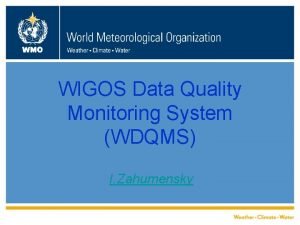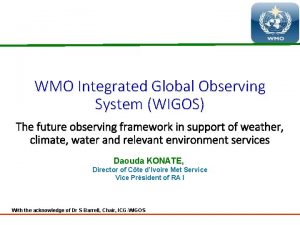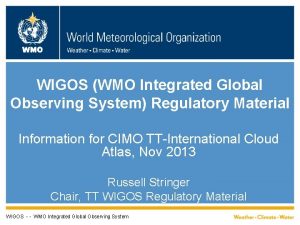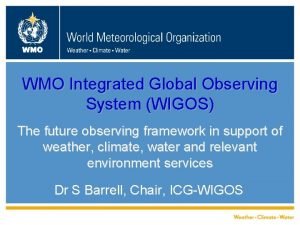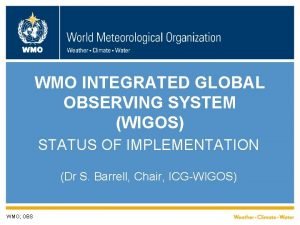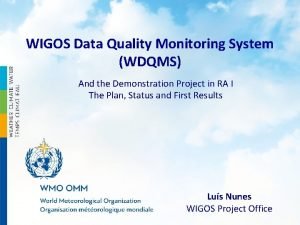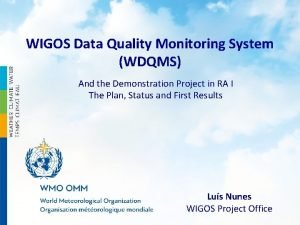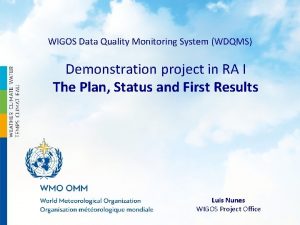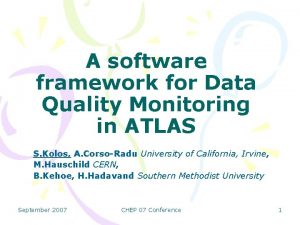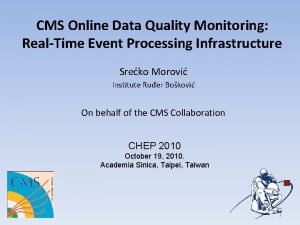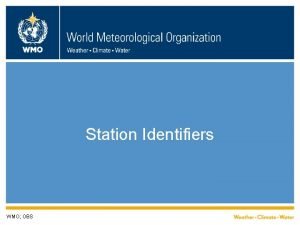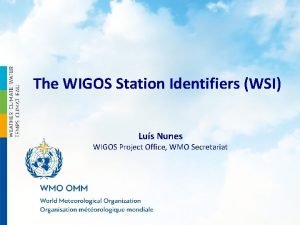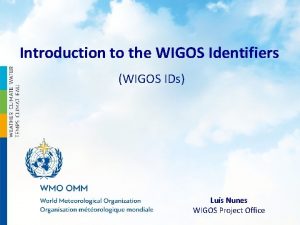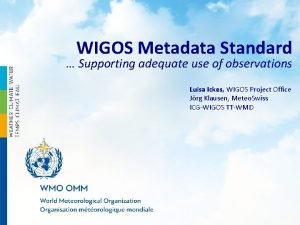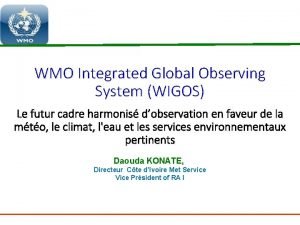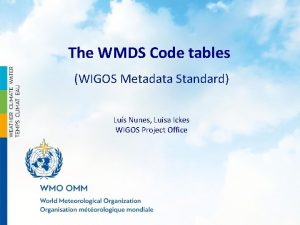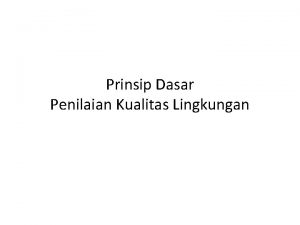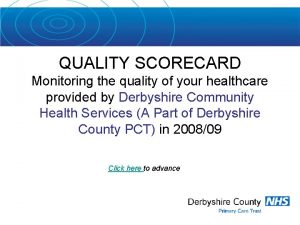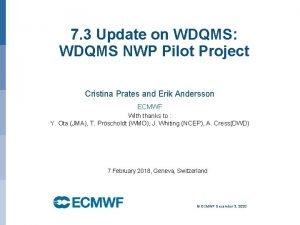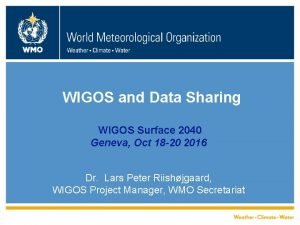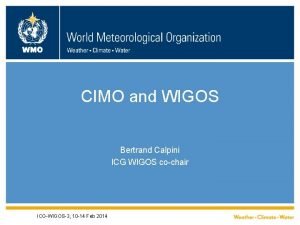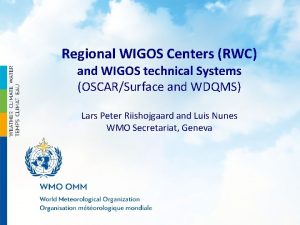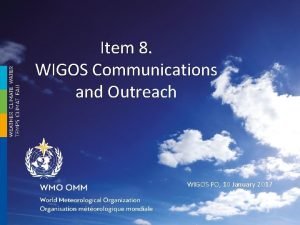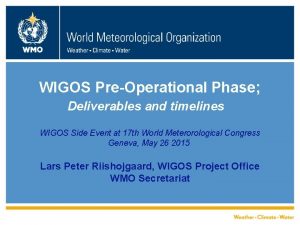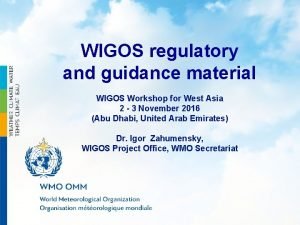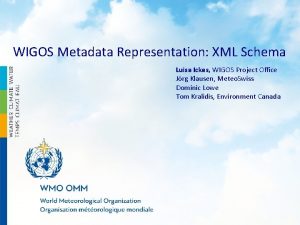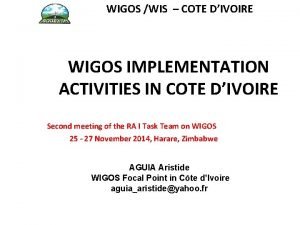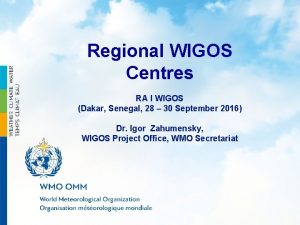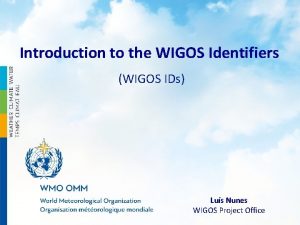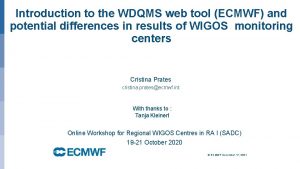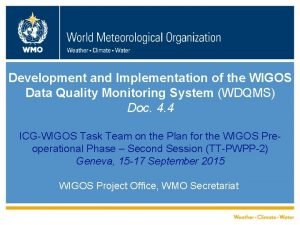WIGOS Data Quality Monitoring System WDQMS And the























- Slides: 23

WIGOS Data Quality Monitoring System (WDQMS) And the Demonstration Project in RA I The Plan, Status and First Results Luís Nunes WIGOS Project Office

Outline I. The Concept and Main Functions II. The Demonstration Project in RA I • • • Rationale (objectives, participants, timeframe) Monitoring tools Incident Management tools/procedures Phases and their status First results III. Next Steps

Outline I. The Concept and Main Functions II. The Demonstration Project in RA I • • • Rationale (objectives, participants, timeframe) Monitoring tools Incident Management tools/procedures Phases and their status First results III. Next Steps

WDQMS - The Concept (1) • Real-time monitoring of data availability and data quality: • searchable by region, country, station type, period, etc. • Monitor regional and national performance of all WIGOS components • Delayed mode monitoring of data quality as measured against reference sources of information. • Incident management system for tracking and mitigation of performance issues. • Demonstration project in RA I, started July 2016 (KMD, TMA, …)

WDQMS - The Concept (2) • Key priority: • development of a modern and efficient performance monitoring and reporting system • Essential for: • measuring the effectiveness and impact of WIGOS, • developing robust practices leading to improved data quality & availability. • An ICG-WIGOS TT on WDQMS, with initially CBS experts: • focusing on NWP-based monitoring of surface-based component of GOS • Substantial resources will be needed: • to develop the initial ideas into an actual system, • to bring in the space-based component of the GOS, • and to broaden the concept to the other WIGOS component systems. • Incremental IT resources will be required to support: • the generation, exchange, storage & analysis of monitoring/incident reports

WDQMS - The Main Functions • The WIGOS Quality Monitoring Function: • essentially provided by Global NWP Centres, by monitoring reports, as a by-product of their data assimilation process; • Initially ECMWF and NCEP, currently also JMA and DWD NWP Centres. • WIGOS Evaluation (and reporting) Function: • based on performance indicators, compared with metadata in OSCAR • automatic reports are produced and made available to national/regional/thematic centres with the issues raised as incidents. • WIGOS Incident Management Function: • Undertakes the incidents raised by the Evaluation function. • Key to the success of this function will be the clear communication: • • with the data providers to ensure they accept and take necessary actions And with data users to ensure they take suitable precautions using the affected data.


But a lot of information is already there: ECMWF Images - snapshots

Outline I. The Concept and Main Functions II. The Demonstration Project in RA I • • • Rationale (objectives, participants, timeframe) Monitoring tools Incident Management tools/procedures Phases and their status First results III. Next Steps

Rationale (1) Background: • Outcome of 2 nd WIGOS Workshop on Quality Monitoring and Incident Management (Geneva, Switzerland December 2015) Goal: • Test the concept of the WIGOS Data Quality Monitoring System (WDQMS) and its major components: QM, Ev and IM functions Steps: A. Planning and preparation of Demonstration Project in RA I: Jan-June 2016; B. Running/testing the QM/Ev/IM functions in operational environment: Jul-Nov 2016; C. Assessment via a dedicated Workshop and follow-up actions: Dec. 2016

Rationale (2) Participants (and acknowledgments): i) Kenya Meteorological Department (KMD) - operations pilot centre, providing temporary local resources (human and technical); ii) Tanzania assessing the issues being identified with their stations; iii) NWP Centres (ECMWF, NCEP, JMA, DWD) providing near real time monitoring results; - Additionally: EUMETNET/EUCOS Governance: - ICG-WIGOS Task Team on WDQMS providing technical advice and support; - WMO Secretariat providing support and training on OSCAR/Surface; Tools to be made available by TT-WDQMS and WMO Secretariat: a) an online monitoring information/processing system, with geographic visualization tools, complemented by other monitoring tools/websites; b) an incident management tracking tool; Other tools/resources: OSCAR/Surface operational and populated

Demonstration Project

Monitoring tools WIGOS Quality Monitoring Web-tool: - for global daily quality monitoring and evaluation (data availability and quality issues) - prototype developed at Secretariat and TT-WDQMS now including a "Country page view" -> http: //128. 65. 196. 37/wdqms ECWMF Wiki page ‘Demonstration Project’: - to identify silent stations, data availability and quality issues: -> https: //software. ecmwf. int/wiki/display/WIGOS/Demonstration+Project WMO Quality Monitoring Portal operated by EUMETNET - detailed statistics to identify and monitor data availability and quality issues, -> https: //eucos. dwd. de/ravi OSCAR/Surface - official source of station metadata information -> https: //oscar. wmo. int/OSCAR

Incident Management Tools/Procedures Based on a (Google) Website: - 1 st prototype developed at WMO Secretariat in collaboration with TT-WDQMS: - for raising, communicating and following incidents -> https: //sites. google. com/a/wmo. int/wdqms-demo-ra-i/home It contains relevant information about the ‘Demonstration Project’: - contacts of people involved, - links to the monitoring tools, - procedures to be followed by participating countries - guidance for the procedures and how to use the website - links to each incident ticket - repository and summary of incident tickets for each country, - everybody involved receives automatic notifications of new tickets created or updates/edits to existing tickets


Phases Phase 1 = Land surface silent stations Phase 2 = phase 1 + availability of land surface stations Phase 3 = phases 1 & 2 + accuracy of pressure observations Phase 4 = phase 1, 2 & 3 + radiosonde stations accuracy & availability

Status of phases 1, 2, 3 (by late October) 1) Land surface silent stations and 2) Data availability of land surface stations 3) Data accuracy of pressure observations from land surface stations • Total of 38 incident tickets have been raised by KMD: – 25 tickets for KMD stations • Only 2 tickets have been closed, • 7 tickets have no follow-up; – 13 tickets for TMA stations • no ticket has been closed, • 6 tickets have no follow-up • 30 incidents refer to silent stations or data availability • 8 incidents refer to data acuracy • Inconsistencies between the tickets and the summaries

Findings from phases 1, 2, 3 • Technical problems: – Editing the website and/or the tickets = solved after some weeks • Functional problems: – Lack of understanding/training on the use of monitoring tools – Slow response from the "actions" side (national or station contacts) • Role of national contact for the follow-up of the incidents? – What to do with Incident tickets that stay open for a long time? • no response, no follow-up, proposed solution not implemented/not adequate • Other problems: – The WIGOS Web-tool for Quality Monitoring not mature yet – Lack of access and/or not updated metadata in OSCAR/Surface • The case of Network/Programme affiliation!

Provisional conclusions • The evaluation function should keep the identified issues under «surveillance» for 5 days, instead of 2, before raising it to incident • The IM system should create/update automatically the summary(ies) of incidents • Is there a need for a "System Coordinator"? • Training is essential: • • for the use of the monitoring tools and the IMS (the Google-site in this case) OSCAR/Surface, particularly for National Focal Points • Technical support (IT) is essential to ensure operations of a IMS • The IMS must be robust and based on standard technology and compatible with current HW/SW existing in the market

Outline I. The Concept and Main Functions II. The Demonstration Project in RA I • • • Rationale (objectives, participants, timeframe) Monitoring tools Incident Management tools/procedures Phases and their status First results III. Next Steps

Next Steps • Phase 4 of the Demonstration project just started: – Four (plus one) training sessions were delivered remotely (via Webex) – End of Demonstration project = Late November 2016 • A TT-WDQMS Meeting/3 rd Workshop: – 13 -15 December, under preparation • Results to be submitted to ICG-WIGOS: – 12 -14 January 2017 (Tentative) • Develop a pilot project on WDQMS by RA II EG-WIGOS?

Next Steps • The Plan for the WIGOS Pre-Operational Phase: (a) Initial WIGOS (land surface stations of the GOS) monitoring capability at various NWP centres, evaluation and incident management functions: by end of 2016; (b) Functional specifications and the pilot components developed, following demonstration project: end 2016; (c) Full WIGOS (GOS surface-based components) operational QM & IM functionality: end of 2018; (d) Monitoring Workshop(s) for JCOMMOPS, GAW, GCOS, GCW and hydrology components of WIGOS: 2016 -17; (e) Initial monitoring capability for all WIGOS components by end of 2018; (f) Mechanisms for routine reporting of monitoring results to EC, regional associations and Members: end 2017; (g) Mechanisms and regional structures in place to handle incident management actions and support Members in improving the data availability and quality: by 2018 (dependent on establishment of RWCs).

Thank you Merci lfnunes@wmo. int www. wmo. int/wigos
 Wigos data quality monitoring system
Wigos data quality monitoring system Wmo wigos
Wmo wigos Wigos system
Wigos system Oswigos
Oswigos Wigos system
Wigos system Wdqms
Wdqms Wdqms
Wdqms Wdqms
Wdqms Data quality monitoring framework
Data quality monitoring framework Real time data quality monitoring
Real time data quality monitoring Wmo station identifiers
Wmo station identifiers Wigos station identifier
Wigos station identifier Wigos station identifier
Wigos station identifier Wigos metadata standard
Wigos metadata standard Wigos
Wigos Wigos metadata standard
Wigos metadata standard Data quality and data cleaning an overview
Data quality and data cleaning an overview Data quality and data cleaning an overview
Data quality and data cleaning an overview Data quality and data cleaning an overview
Data quality and data cleaning an overview Data-data monitoring lingkungan merupakan gambaran dari
Data-data monitoring lingkungan merupakan gambaran dari Perform quality assurance
Perform quality assurance Basic quality concepts
Basic quality concepts Quality monitoring scorecard
Quality monitoring scorecard Quality monitoring scorecard
Quality monitoring scorecard
